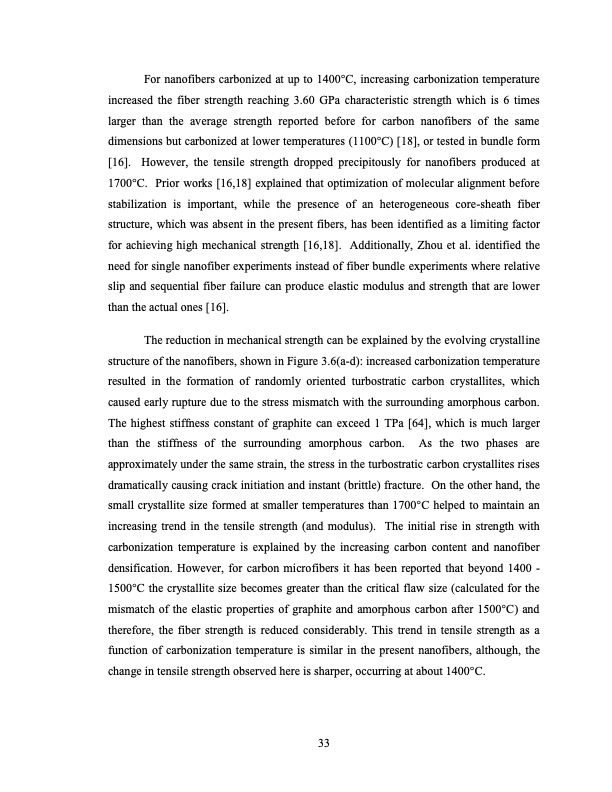
PDF Publication Title:
Text from PDF Page: 040
For nanofibers carbonized at up to 1400°C, increasing carbonization temperature increased the fiber strength reaching 3.60 GPa characteristic strength which is 6 times larger than the average strength reported before for carbon nanofibers of the same dimensions but carbonized at lower temperatures (1100°C) [18], or tested in bundle form [16]. However, the tensile strength dropped precipitously for nanofibers produced at 1700°C. Prior works [16,18] explained that optimization of molecular alignment before stabilization is important, while the presence of an heterogeneous core-sheath fiber structure, which was absent in the present fibers, has been identified as a limiting factor for achieving high mechanical strength [16,18]. Additionally, Zhou et al. identified the need for single nanofiber experiments instead of fiber bundle experiments where relative slip and sequential fiber failure can produce elastic modulus and strength that are lower than the actual ones [16]. The reduction in mechanical strength can be explained by the evolving crystalline structure of the nanofibers, shown in Figure 3.6(a-d): increased carbonization temperature resulted in the formation of randomly oriented turbostratic carbon crystallites, which caused early rupture due to the stress mismatch with the surrounding amorphous carbon. The highest stiffness constant of graphite can exceed 1 TPa [64], which is much larger than the stiffness of the surrounding amorphous carbon. As the two phases are approximately under the same strain, the stress in the turbostratic carbon crystallites rises dramatically causing crack initiation and instant (brittle) fracture. On the other hand, the small crystallite size formed at smaller temperatures than 1700°C helped to maintain an increasing trend in the tensile strength (and modulus). The initial rise in strength with carbonization temperature is explained by the increasing carbon content and nanofiber densification. However, for carbon microfibers it has been reported that beyond 1400 - 1500°C the crystallite size becomes greater than the critical flaw size (calculated for the mismatch of the elastic properties of graphite and amorphous carbon after 1500°C) and therefore, the fiber strength is reduced considerably. This trend in tensile strength as a function of carbonization temperature is similar in the present nanofibers, although, the change in tensile strength observed here is sharper, occurring at about 1400°C. 33PDF Image | HIGH STRENGTH CARBON NANOFIBERS DERIVED FROM ELECTROSPUN POLYACRYLONITRILE

PDF Search Title:
HIGH STRENGTH CARBON NANOFIBERS DERIVED FROM ELECTROSPUN POLYACRYLONITRILEOriginal File Name Searched:
4835609.pdfDIY PDF Search: Google It | Yahoo | Bing
Sulfur Deposition on Carbon Nanofibers using Supercritical CO2 Sulfur Deposition on Carbon Nanofibers using Supercritical CO2. Gamma sulfur also known as mother of pearl sulfur and nacreous sulfur... More Info
CO2 Organic Rankine Cycle Experimenter Platform The supercritical CO2 phase change system is both a heat pump and organic rankine cycle which can be used for those purposes and as a supercritical extractor for advanced subcritical and supercritical extraction technology. Uses include producing nanoparticles, precious metal CO2 extraction, lithium battery recycling, and other applications... More Info
| CONTACT TEL: 608-238-6001 Email: greg@infinityturbine.com | RSS | AMP |